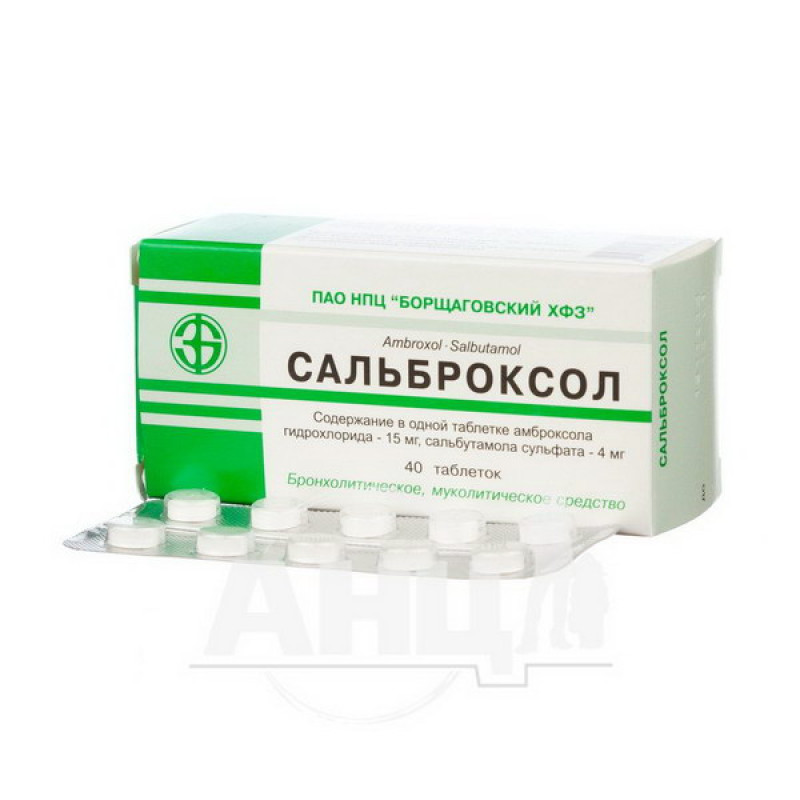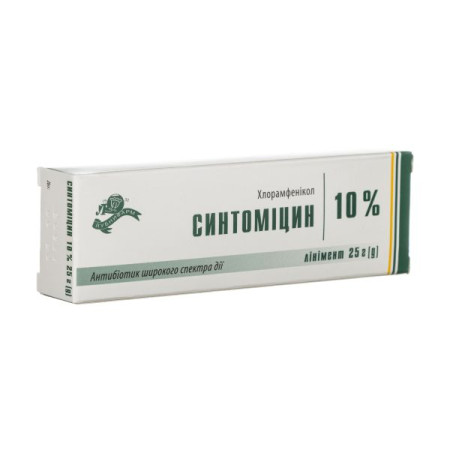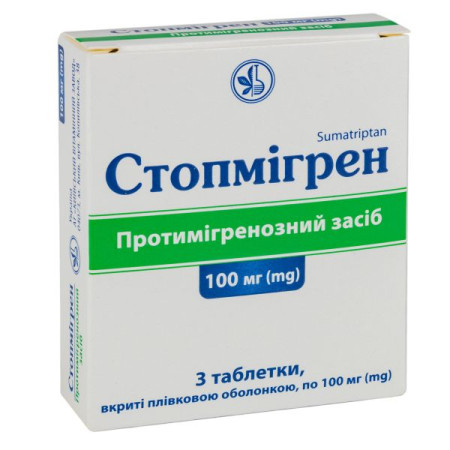Salbroxol tablets blister pack No. 40

Pharmacological properties
A combined medicinal product, the therapeutic effect of which is due to the pharmacological properties of the active components that make up its composition.
Pharmacodynamics. Ambroxol - secretolytic and secretomotor of the benzylamine group. Normalizes pathologically altered formation of bronchial secretion by stimulating serous cells of the glands of the bronchial mucosa, as a result of which the content of mucous secretion increases and the ratio of mucous and serous components of sputum changes. Ambroxol activates hydrolyzing enzymes and enhances the release of lysosomes from Clark cells, changes the structure of bronchial secretion by reducing and fragmenting mucopolysaccharide fibers, selectively inhibits the absorption of sodium by the epithelium of the respiratory tract, which leads to a decrease in sputum viscosity. Enhances the movement of cilia of the ciliated epithelium of the bronchi, increasing mucociliary transport of sputum, which facilitates its discharge. In addition, ambroxol stimulates the synthesis of surfactant phospholipids by alveolar pneumocytes, has an antioxidant effect. Ambroxol penetrates well through the placental barrier and improves surfactant synthesis during intrauterine development of the fetus.
Salbutamol is a selective β 2 -adrenergic agonist. It has a bronchodilator effect, prevents and eliminates bronchospasm, reduces resistance in the respiratory tract, increases the vital capacity of the lungs. It increases the resistance of mast cells and basophils to degranulation upon contact with an allergen and thereby prevents the release of histamine, slowly reacts with anaphylactic substances and neutrophil chemotaxis factor. Compared with other β 2-adrenergic agonists, salbutamol has a less pronounced positive chrono- and inotropic effect on the myocardium, practically does not change blood pressure and heart rate.
Pharmacokinetics. Ambroxol after oral administration is rapidly and completely absorbed in the gastrointestinal tract. The pharmacological effect occurs 30 minutes after taking the drug, C max in blood plasma is detected after 1-3 hours and is maintained for 6-12 hours. The bioavailability of ambroxol is 30%. This is due to the effect of the first passage through the liver. Binding to plasma proteins is about 85%. About 90% of ambroxol is excreted from the body in the form of metabolites with urine, less than 10% - in unchanged form.
Salbutamol binds to plasma proteins to a small extent, its bioavailability when administered orally is 40-50%. T ½ for salbutamol and its active metabolite is 6 hours. The main metabolites of salbutamol are conjugated sulfates (42%), the main of which is salbutamol ester sulfate, which has a β 2 -adrenostimulating effect. Conjugated sulfates are excreted mainly in the urine and to a lesser extent in the bile.
Salbutamol and ambroxol penetrate the placental barrier and are secreted into breast milk.
Indication
Ba; chronic obstructive bronchitis; emphysema of the lungs.
Application
It is used orally. Adults and children over 12 years of age are prescribed 1 tablet 3-4 times a day.
The drug should be taken between meals. The intervals between doses should be at least 6 hours.
For adults, if necessary, the dose of the drug can be increased to 2 tablets 4 times a day.
If side effects occur, it is recommended to reduce the dose to 1/2 tablet 4 times a day.
The duration of treatment is determined by the doctor depending on the clinical picture of the disease.
Contraindication
Hypersensitivity to the components of the drug; tachyarrhythmia; angina pectoris; myocarditis; heart defects; acute heart failure; gastric and duodenal ulcers; diabetes mellitus; hyperthyroidism; thyrotoxicosis; glaucoma; use of β-adrenoceptor blockers, especially non-selective ones; I trimester of pregnancy; breastfeeding period; children under 12 years of age.
Side effects
Hand tremor, tension; less often - short-term peripheral vasodilation, headache, dizziness, moderate tachycardia, nausea, vomiting, feeling of fullness of the stomach, epigastric pain, diarrhea, anorexia, difficulty urinating, sweating, increased blood glucose levels.
In rare cases - angioedema, allergic reactions in the form of skin rashes, arterial hypotension, collapse, paradoxical bronchospasm, muscle cramps.
Special instructions
Increasing the dose or reducing the intervals between doses of the drug should be carried out under the supervision of a doctor. Reducing the interval is possible only in exceptional cases and must be strictly justified.
When using salbroxol, hypokalemia may develop, so the level of potassium in the blood should be monitored during treatment.
The drug should be used with caution in patients with liver and/or kidney diseases.
Use during pregnancy and breastfeeding. The use of the drug in the first trimester of pregnancy is contraindicated. When prescribing in the second and third trimesters of pregnancy, the benefit/risk ratio should be taken into account.
If it is necessary to use the drug by women who are breastfeeding, breastfeeding is recommended to be discontinued.
Ability to influence the reaction rate when driving vehicles or operating other mechanisms. The use of the drug may impair the reaction when driving vehicles and operating mechanisms. This effect is enhanced by the simultaneous use of alcohol and tranquilizers.
Interactions
The antagonistic effect (in relation to salbutamol) of β-adreceptor blockers not only weakens the bronchodilator effect of the drug, but can also increase bronchospasm.
The combination with M-cholinergic blockers and theophylline increases the severity and duration of bronchodilation, but increases the risk of tachycardia and arrhythmia, in particular supraventricular extrasystole.
GCS increase the sensitivity of receptors to agonists and β-blockers, including salbutamol.
Ambroxol, which is part of the drug, improves the penetration of antibiotics into bronchial secretions.
Simultaneous use of antitussives (codeine, glaucine, etc.) may worsen sputum discharge.
With simultaneous use of xanthine derivatives, glucocorticosteroids, cardiac glycosides, diuretics, there is a risk of developing hypokalemia.
When used simultaneously with antidepressants and MAO inhibitors, the effect of salbutamol may be enhanced and blood pressure may drop sharply.
Overdose
It is manifested by tachycardia, arrhythmia, sleep disturbance, chest pain, tremor of the hands and the whole body. When taking the drug in high doses, it can cause serious complications: arterial hypotension, collapse, angioedema.
Treatment is symptomatic - gastric lavage is performed, cardioselective β 1 -adrenergic blockers are prescribed.
Storage conditions
In a dry, dark place at a temperature not exceeding 25 °C.
There are no reviews for this product.
There are no reviews for this product, be the first to leave your review.
No questions about this product, be the first and ask your question.
















